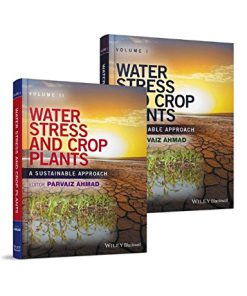Phenotyping crop plants for physiological and biochemical traits 1st Edition by Latha, Sudhakar, Reddy 0128040734 9780128040737
$50.00 Original price was: $50.00.$25.00Current price is: $25.00.
Phenotyping crop plants for physiological and biochemical traits 1st Edition by P. Latha, P. Sudhakar, P. V. Reddy – Ebook PDF Instant Download/DeliveryISBN: 0128040734, 9780128040737
Full download Phenotyping crop plants for physiological and biochemical traits 1st Edition after payment.

Product details:
ISBN-10 : 0128040734
ISBN-13 : 9780128040737
Author: P. Latha, P. Sudhakar, P. V. Reddy
Phenotyping Crop Plants for Physiological and Biochemical Traits presents a proven range of methodologies and practices for effective, efficient, and appropriate typing of crop plants. By addressing the basic principles and precautions needed when conducting crop-based experiments, this book guides the reader in selecting the appropriate method based on the growing environment, whether greenhouse, pot, field, or liquid (hydroponic). By addressing the quantification of seed traits related to growth experiments, including their viability and vigor, this book presents methodology options for optimum yield based on potential abiotic stresses.
Phenotyping crop plants for physiological and biochemical traits 1st Table of contents:
Section I
Chapter 1: Various methods of conducting crop experiments
Abstract
1.1. Field experiments
1.2. Experiments under green houses
1.3. Experiments in growth chambers
1.4. Hydroponics
1.5. Pot culture
Section II
Chapter 2: Seed physiological and biochemical traits
Abstract
2.1. Destructive methods
2.2. Nondestructive methods
Section III
Chapter 3: Plant growth measurements
Abstract
3.1. Measurement of growth
3.2. Measurement of below ground biomass
3.3. Growth analysis
Chapter 4: Photosynthetic rates
Abstract
4.1. Net assimilation rate (NAR)
4.2. Measuring through infrared gas analyzer (IRGA)
4.3. Rubisco enzyme activity
4.4. Chlorophyll fluorescence ratio (Fv/Fm values)
Chapter 5: Drought tolerance traits
Abstract
5.1. Water use efficiency (WUE) traits
5.2. Root traits
Chapter 6: Other drought-tolerant traits
Abstract
6.1. Relative water content (RWC)
6.2. Chlorophyll stability index (CSI)
6.3. Specific leaf nitrogen (SLN)
6.4. Mineral ash content
6.5. Leaf anatomy
6.6. Leaf pubescence density
6.7. Delayed senescence or stay-greenness
6.8. Leaf waxiness
6.9. Leaf rolling
6.10. Leaf thickness (mm)
6.11. Stomatal index and frequency
6.12. Other indicators for drought tolerance
6.13. Phenological traits
Chapter 7: Tissue water related traits
Abstract
7.1. Osmotic potential
7.2. Leaf water potential
7.3. Relative water content
7.4. Cell membrane injury
Chapter 8: Heat stress tolerance traits
Abstract
8.1. Canopy temperature
8.2. Chlorophyll stability index (CSI)
8.3. Chlorophyll fluorescence
8.4. Thermo induction response (TIR) technique
8.5. Membrane stability index
Chapter 9: Oxidative stress tolerance traits
Abstract
9.1. Oxidative damage
9.2. Superoxide dismutase (SOD)
9.3. Catalase
9.4. Peroxidase (POD)
9.5. Free radicals
Chapter 10: Salinity tolerance traits
Abstract
10.1. Chlorophyll stability index
10.2. Proline
10.3. Sodium (Na) and potassium (K) ratio
10.4. Antioxidative enzymes
Section IV
Chapter 11: Kernel quality traits
Abstract
11.1. Proteins
11.2. Kernel oil
11.3. Aflatoxins
Chapter 12: Carbohydrates and related enzymes
Abstract
12.1. Reducing sugars
12.2. Nonreducing sugars
12.3. Total carbohydrates
12.4. Estimation of sucrose phosphate synthase
12.5. Estimation of starch synthase
12.6. Estimation of invertases
Chapter 13: Nitrogen compounds and related enzymes
Abstract
13.1. Total nitrogen
13.2. Total free amino acids
13.3. Nitrate reductase
13.4. Nitrite reductase
13.5. Leghemoglobin (Lb)
13.6. Glutamic acid dehydrogenase (GDH)
13.7. Glutamate synthase (GOGAT)
13.8. Glutamine synthetase (GS)
Chapter 14: Other biochemical traits
Abstract
14.1. Total phenols
14.2. Ascorbic acid
14.3. Alcohol dehydrogenase (ADH)
14.4. Glycine betaine
Chapter 15: Plant pigments
Abstract
15.1. Chlorophylls
15.2. Carotenoids
15.3. Lycopene
15.4. Anthocyanin
Chapter 16: Growth regulators
Abstract
16.1. Estimation of indole acetic acid (IAA)
16.2. Estimation of gibberellins
16.3. Estimation of abscisic acid (ABA)
16.4. Estimation of ethylene
Section V
Chapter 17: Analytical techniques
Abstract
17.1. Ultraviolet visible (UV–VIS) spectrophotometer
17.2. Thin layer chromatography (TLC)
17.3. Gas chromatography (GC)
17.4. High-performance liquid chromatography (HPLC)
17.5. Liquid chromatography–mass spectrometry (LC–MS, or alternatively HPLC–MS)
17.6. Inductively coupled plasma spectrometry (ICP) (Soil & Plant Analysis Laboratory University of Wisco
People also search for Phenotyping crop plants for physiological and biochemical traits 1st:
what is crop phenotyping
physiological disorders of flower crops
phenotype plants
phenotyping agronomist
what are cover crop plants
Tags: Phenotyping, crop plants, physiological, biochemical traits, Latha, Sudhakar, Reddy
You may also like…
Science (General)
Biology and other natural sciences - Plants: Agriculture and Forestry
Biology and other natural sciences - Plants: Botany
Science (General)
Engineering Nitrogen Utilization in Crop Plants Ashok Shrawat












